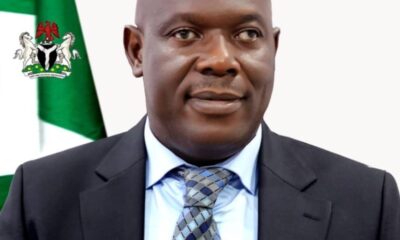Opinion
Texas Of Icy Trauma
I had earlier stated in this column that even with all the hoopla about the United States of America being a very lovely dwelling place on Earth, her geography still comprises a tale of some deadly weather vagaries.
Depending on which part of the vast subcontinent one looks at, disaster can come from a severe snowstorm, tornado, hurricane, earthquake or wildfire. While snow and wildfire can be associated with particular seasons of the year, the rest are very likely to occur at any moment and on any day. The good thing, though, is that nearly all can be predicted by the relevant agencies of government with alerts posted in advance and emergency preparations made. Of course, things work pretty well over there – quite unlike they do here.
However, climate change seems to be testing the skills of geographers and their weather instruments. In the US, the government had since signed up to the Paris protocol on climate but that was until the outgone administration of President Donald Trump elected to pull the nation out of the deal. Luckily, his successor, President Joe Biden, is pushing to take God’s Own Country back to the comity of nations on global warming.
No doubt, Trump’s action must have angered the likes of Sen. Al Gore, a former vice president and the Democratic Party’s presidential candidate in 2000, who has garnered global acclaim on account of his effort to promote a sustainable green culture in the world.
It is already obvious that the erstwhile Republican president never reckoned with the fact that states in southern US which had hitherto served as hibernation grounds for people from the snowy northern and central regions are now beginning to experience blizzards of their own. Texas, Louisiana, Mississippi, Tennessee, North Carolina, South Carolina, Georgia and Florida are among states in this region.
Until recently, snowfall in the region had reportedly been mostly mild and incident-free. Whereas the winter season became evident in the north from late November, its effect was rarely felt in these southern states until January. So also did it recede fast, sometimes beginning from late February. But last winter was of an entirely different species. Not only were there reports of strong winds and snowstorms, the ice also manifested an unprecedented staying strength. The case of Texas was made particularly more pathetic because of its energy systems collapse which left many families without electricity, gas or even coal to heat their homes.
Texas is said to operate about 15,000 wind turbines aimed at providing electricity while also promoting green energy; but at the onset of the cold snap, ice on the rotor blades had reduced the speed of more than half of them; thereby hampering their collective power generation capability. More than four million Texans were said to be without electricity for much of the period. And the state obtains a quarter of its electricity from these turbines.
Gas pipes and water supply lines were also reported to have been frozen by the extreme weather condition. Those who still had running taps were advised to boil their water before use as water treatment plants lacked electricity to function. Some of the unlucky ones simply collected snow from outside their homes to melt for water. Believe me, it was said to be that bad in America’s Lone Star State. Close friends and relatives living in Texas and Georgia called to confirm this to me.
The deadly storm which was said to have begun on February 13, had endured for five days. And while it lasted, temperatures plummeted to as low as zero degree Fahrenheit; resulting in the closure of schools and some hospitals. A number of popular roads were also closed due to the unprecedented build-up of snow. People, especially the more vulnerable children and the elderly, were mostly wrapped in layers of heavy clothing and restrained indoors for much of the day. Food became scarce as grocery stores quickly ran out of stock with anxiety over the arrival of any fresh supplies. Even the delivery of COVID-19 vaccines was hampered.
Residents who could not stand the frightening scenario and had the means reportedly left for nearby Central American countries; including Texas Republican senator and former presidential aspirant, Ted Cruz, who was berated by the American press for going on vacation at a sunny beach resort in Cancun, Mexico when his state’s voters were battling with freezing conditions made worse by food and utility shortages. As at July, the total tally of casualties across Texas was put at 210. I want to believe that Texans have now shaken off their trauma and are fully braced for the start of the next winter season this November.
The big lesson here is that while nations are making attempts to embrace renewable energy, they should not be in a haste to jettison fossil fuels. It would have been worse if not that Texas had a strategic reserve of refined petroleum products to serve as a stop-gap measure at the time the wind turbines packed up. It is even said that officials in New York, Massachusetts, Connecticut and some other Northeast US states have suddenly become sceptical of their ongoing development of wind turbines following the Texas experience.
For the people of Mexico, the events in Texas can only suggest one thing – severe winter is just a matter of years, if not months. Climate change is real. But rather than being checked by the increasing global heat, snowstorms are fast reaching for the tropics. For Nigeria, who said we’re unlikely to witness icy weather sooner than later?
Howbeit, some experts have opined that, considering its huge investment in wind turbines, Texas officials should have equipped such facilities with heaters and anti-freeze fluids as is the case in some parts of Alaska and Canada which experience equally harsh but longer winter seasons.
Much of Texas already lies in America’s Tornado Alley. Its major southern towns of Houston, Corpus Christi and Beaumont are often battered by tropical winds from the Gulf of Mexico. The oil-rich state is also known to be earthquake prone. And now it has joined the infamous club of deadly snowstorm states. Haba, Texas!
By: Ibelema Jumbo
Opinion
Ndifon’s Verdict and University Power Reform

Opinion
As Nigeria’s Insecurity Rings Alarm

Opinion
The Girl Who Didn’t Dance
-

 Featured2 days ago
Featured2 days agoOil & Gas: Rivers Remains The Best Investment Destination – Fubara
-

 Nation3 days ago
Nation3 days agoOgoni Power Project: HYPREP Moves To Boost Capacity Of Personnel
-
Nation3 days ago
Hausa Community Lauds Council Boss Over Free Medical Outreach
-
Nation3 days ago
Association Hails Rivers LG Chairmen, Urges Expansion Of Dev Projects
-
Nation3 days ago
Film Festival: Don, Others Urge Govt To Partner RIFF
-
Nation2 days ago
MOSIEND Calls For RSG, NDDC, Stakeholders’ Intervention In Obolo Nation
-

 News2 days ago
News2 days agoNDLEA Arrests Two, Intercepts Illicit Drugs Packaged As Christmas Cookies
-
Rivers3 days ago
UNIPORT Moves To Tackle Insecurity … Inducts Security Experts

